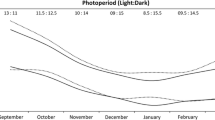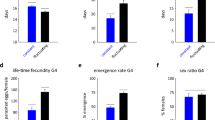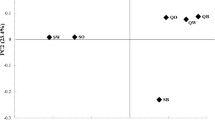Abstract
Laboratory insect rearing provides well-developed tested insects for research in general biology, pest science and development of pest management technology and products. The effects of environmental conditions on various traits in laboratory populations are often extrapolated to field populations; for example, the thermal performances of laboratory populations are used to predict the phenology and abundance of wild pest populations. However, these studies generally do not consider the potential rapid evolution of the laboratory populations. Therefore, it is not certain whether laboratory populations reflect the performance of field populations in natural fluctuating and sometimes extreme conditions. Here, we used a global insect pest, the English grain aphid [Sitobion avenae (Hemiptera: Aphididae)] as the model system, to compare the demography of field and laboratory populations experimentally under constant and ecologically relevant fluctuating temperatures. Our results indicated that the field population adapted better to fluctuating temperatures and high temperatures. By contrast, the laboratory population adapted better to mild constant temperatures but reduced ability to withstand extremely high temperatures under diurnal fluctuations and chronic high temperatures. Therefore, caution is needed when extending the ecological effects of temperature from laboratory populations to wild populations, especially in environments with extreme events. Laboratory populations require regular replenishing or rearing under fluctuating temperature conditions to maintain the genetic diversity and prevent rapid adaptation to rearing environments.







Similar content being viewed by others
Data availability
All datasets generated during the current study are included in this published article (and its supplementary information files).
References
Abbes K, Biondi A, Kurtulus A et al (2015) Combined non-target effects of insecticide and high temperature on the Parasitoid Bracon nigricans. Plos One 10:e0138411. https://doi.org/10.1371/journal.pone.0138411
Alford L, Blackburn TM, Bale JS (2012) Effects of acclimation and latitude on the activity thresholds of the aphid Myzus persicae in Europe. J Appl Entomol 136:332–346. https://doi.org/10.1111/j.1439-0418.2011.01658.x
Bennett AF, Lenski RE (1993) Evolutionary adaptation to temperature II. Thermal niches of experimental lines of Escherichia coli. Evolution 47:1–12. https://doi.org/10.1111/j.1558-5646.1993.tb01194.x
Bennett AF, Lenski RE, Mittler JE (1992) Evolutionary adaptation to temperature I. Fitness responses of Escherichia coli to changes in its thermal environment. Evolution 46:16–30. https://doi.org/10.1111/j.1558-5646.1992.tb01981.x
Bozinovic F, Bastías DA, Boher F, Clavijo-Baquet S, Estay SA, Angilletta MJ Jr (2011) The mean and variance of environmental temperature interact to determine physiological tolerance and fitness. Physiol Biochem Zool 84:543–552. https://doi.org/10.1086/662551
Cao JY, Xing K, Zhao F (2021) Complex delayed and transgenerational effects driven by the interaction of heat and insecticide in the maternal generation of the wheat aphid. Sitobion Avenae Pest Manag Sci 77:4453–4461. https://doi.org/10.1002/ps.6480
Chen X, Li F, Chen A et al (2017) Both point mutations and low expression levels of the nicotinic acetylcholine receptor β1 subunit are associated with imidacloprid resistance in an Aphis gossypii (Glover) population from a bt cotton field in China. Pestic Biochem Physiol 14:1–8. https://doi.org/10.1016/j.pestbp.2016.11.004
Chi H, Liu H (1985) Two new methods for the study of insect population ecology. Bull Inst Zool Acad Sin 24:225–240
Chi H, You M, Atlihan R et al (2020) Age-stage, two-sex life table: an introduction to theory, data analysis, and application. Entomol Gene 40:103–124. https://doi.org/10.1127/entomologia/2020/0936
Colinet H, Sinclair BJ, Vernon P, Renault D (2015) Insects in fluctuating thermal environments. Annu Rev Entomol 60:123–140. https://doi.org/10.1146/annurev-ento-010814-021017
Cooper VS, Bennett AF, Lenski RE (2001) Evolution of thermal dependence of growth rate of Escherichia coli populations during 20,000 generations in a constant environment. Evolution 55:889–896. https://doi.org/10.1111/j.0014-3820.2001.tb00606.x
Diamond SE, Hawkins SD, Nijhout HF, Kingsolver JG (2010) Evolutionary divergence of field and laboratory populations of Manduca sexta in response to host-plant quality. Ecol Entomol 35:166–174. https://doi.org/10.1111/j.1365-2311.2009.01166.x
Futuyma DJ, Moreno G (1988) The Evolution of ecological specialization. Annu Rev Ecol Syst 19:207–233. https://doi.org/10.1146/annurev.es.19.110188.001231
Geerts AN, Vanoverbeke J, Vanschoenwinkel B et al (2015) Rapid evolution of thermal tolerance in the water flea Daphnia. Nat Clim Chang 5:665–668. https://doi.org/10.1038/NCLIMATE2628
Gilchrist GW (1995) Specialists and generalists in changing environments I. Fitness landscapes of thermal sensitivity. Am Nat 146:253–270. https://doi.org/10.1086/285797
Golec JR, Duan JJ, Rim K, Hough-Goldstein J, Aparicio EA (2019) Laboratory adaptation of a native North American parasitoid to an exotic wood-boring beetle: implications for biological control of invasive pests. J Pest Sci 92:1179–1186. https://doi.org/10.1007/s10340-019-01101-z
Gu LL, Li MZ, Wang GR, Liu XD (2019) Multigenerational heat acclimation increases thermal tolerance and expression levels of hsp70 and hsp90 in the rice leaf folder larvae. J Therm Biol 81:103–109. https://doi.org/10.1016/j.jtherbio.2019.02.024
Gul H, Ullah F, Biondi A, Desneux N (2019) Resistance against clothianidin and associated fitness costs in the chive maggot. Bradysia Odoriphaga Entomol Gen 39:81–92. https://doi.org/10.1127/entomologia/2019/0861
Han P, Niu CY, Lei CL, Cui JJ, Desneux N (2010) Quantification of toxins in a Cry1Ac+ CpTI cotton cultivar and its potential effects on the honey bee Apis mellifera L. Ecotoxicology 19:1452–1459. https://doi.org/10.1007/s10646-010-0530-z
Harshman LG, Hoffmann AA (2000) Laboratory selection experiments using Drosophila: what do they really tell us? Trends Ecol Evol 15:32–36. https://doi.org/10.1016/S0169-5347(99)01756-5
He ZH, Rajaram S, Xin ZY, Huang GZ (Eds) (2001) Wheat and wheat breeding in China: an overview. In: A history of wheat breeding in China. CIMMYT. Mexico 114
Hoffmann AA, Ross PA (2018) Rates and patterns of laboratory adaptation in (mostly) insects. J Econ Entomol 111:501–509. https://doi.org/10.1093/jee/toy024
Hullé M, d’Acier AC, Bankhead-Dronnet S, Harrington R (2010) Aphids in the face of global changes. CR Biol 333:497–503. https://doi.org/10.1016/j.crvi.2010.03.005
Ketola T, Laakso J, Kaitala V, Airaksinen S (2004) Evolution of hsp90 expression in Tetrahymena thermophila (Protozoa, Ciliata) populations exposed to thermally variable environments. Evolution 58:741–748. https://doi.org/10.1111/j.0014-3820.2004.tb00407.x
Ketola T, Mikonranta L, Zhang J et al (2013) Fluctuating temperature leads to evolution of thermal generalism and preadaptation to novel environments. Evolution 67:2936–2944. https://doi.org/10.1111/evo.12148
Kingsolver JG, Nagle A (2007) Evolutionary divergence in thermal sensitivity and diapause of field and laboratory populations of Manduca sexta. Physiol Biochem Zool 80:473–479. https://doi.org/10.1086/519962
Kingsolver JG, Ragland GJ, Diamond SE (2009) Evolution in a constant environment: thermal fluctuations and thermal sensitivity of laboratory and field populations of Manduca sexta. Evolution 63:537–541. https://doi.org/10.1111/j.1558-5646.2008.00568.x
Kingsolver JG, Moore ME, Hill CA, Augustine KE (2020) Growth, stress, and acclimation responses to fluctuating temperatures in field and domesticated populations of Manduca sexta. Ecol Evol 10:13980–13989. https://doi.org/10.1002/ece3.6991
Leonard A, Egonyu JP, Tanga CM et al (2021) Predicting the current and future distribution of the edible long-horned grasshopper Ruspolia differens (Serville) using temperature-dependent phenology models. J Therm Biol 95:102786. https://doi.org/10.1016/j.jtherbio.2020.102786
Leroi AM, Lenski RE, Bennett AF (1994) Evolutionary adaptation to temperature. III Adaptation of Escherichia coli to a temporally varying environment. Evolution 48:1222–1229. https://doi.org/10.1111/j.1558-5646.1994.tb05307.x
Li S, Zheng Y, Wu R et al (2016) Observation of ozone dry deposition in the field of winter wheat. Chin J Appl Entomol 27:1811–1819. https://doi.org/10.13287/j.1001-9332.201606.037
Llewellyn KS, Loxdale HD, Harrington R, Clark SJ, Sunnucks P (2004) Evidence for gene flow and local clonal selection in field populations of the grain aphid (Sitobion avenae) in Britain revealed using microsatellites. Heredity (edinb) 93:143–153. https://doi.org/10.1038/sj.hdy.6800466
Loxdale HD (2008) The nature and reality of the aphid clone: genetic variation, adaptation and evolution. Agric for Entomol 10:81–90. https://doi.org/10.1111/j.1461-9563.2008.00364.x
Lushai G, Loxdale HD (2002) The biological improbability of a clone. Genet Res 79:1–9. https://doi.org/10.1017/S0016672301009582
Lynch M, Gabriel W (1987) Environmental tolerance. Am Nat 129:283–303. https://doi.org/10.1086/284635
Lyon C, Saupe EE, Smith CJ et al (2021) Climate change research and action must look beyond 2100. Glob Chang Biol 28:349–361. https://doi.org/10.1111/gcb.15871
Ma G, Hoffmann AA, Ma CS (2015) Daily temperature extremes play an important role in predicting thermal effects. J Exp Biol 218:2289–2296. https://doi.org/10.1242/jeb.122127
Ma CS, Wang L, Zhang W, Rudolf VH (2018) Resolving biological impacts of multiple heat waves: interaction of hot and recovery days. Oikos 127:622–633. https://doi.org/10.1111/oik.04699
Ma CS, Ma G, Pincebourde S (2021) Survive a warming climate: insect responses to extreme high temperatures. Annu Rev Entomol 66:163–184. https://doi.org/10.1146/annurev-ento-041520-074454
Maclean HJ, Kristensen TN, Sørensen JG, Overgaard J (2018) Laboratory maintenance does not alter ecological and physiological patterns among species: a Drosophila case study. J Evol Biol 31:530–542. https://doi.org/10.5061/dryad.qv275
Madbouni MAZ, Samih MA, Namvar P, Biondi A (2017) Temperature-dependent functional response of Nesidiocoris tenuis (Hemiptera: Miridae) to different densities of pupae of cotton whitefly, Bemisia tabaci (Hemiptera: Aleyrodidae). Eur J Endocrinol 114:325–331. https://doi.org/10.14411/EJE.2017.040
Manenti T, Loeschcke V, Moghadam NN, Sørensen JG (2015) Phenotypic plasticity is not affected by experimental evolution in constant, predictable or unpredictable fluctuating thermal environments. J Evol Biol 28:2078–2087. https://doi.org/10.1111/jeb.12735
Michel AP, Zhang W, Mian MAR (2010) Genetic diversity and differentiation among laboratory and field populations of the soybean aphid, Aphis glycines. Bull Entomol Res 100:727–734. https://doi.org/10.1017/S000748531000012X
Moritz C, Agudo R (2013) The future of species under climate change: resilience or decline? Science 341:504–508. https://doi.org/10.1126/science.1237190
Muñoz-Valencia V, González-Obando R, Díaz F (2016) Rapid responses to a strong experimental selection for heat hardening in the invasive whitefly Bemisia tabaci MEAM1. Entomol Exp Appl 160:147–155. https://doi.org/10.1111/eea.12466
Naseri B, Majd-Marani S (2020) Assessment of eight rice cultivars flour for feeding resistance to Tribolium castaneum (Herbst)(Coleoptera: Tenebrionidae). J Stored Prod Res 88:101650. https://doi.org/10.1016/j.jspr.2020.101650
Nikolouli K, Sassù F, Mouton L, Stauffer C, Bourtzis K (2020) Combining sterile and incompatible insect techniques for the population suppression of Drosophila suzukii. J Pest Sci 93:647–661. https://doi.org/10.1007/s10340-020-01199-6
Oliver KM, Russell JA, Moran NA, Hunter MS (2003) Facultative bacterial symbionts in aphids confer resistance to parasitic wasps. Proc Natl Acad Sci USA 100:1803–1807. https://doi.org/10.1073/pnas.0335320100
Paaijmans KP, Heinig RL, Seliga RA et al (2013) Temperature variation makes ectotherms more sensitive to climate change. Glob Change Biol 19:2373–2380. https://doi.org/10.1111/gcb.12240
Partridge L, Barrie B, Barton NH, Fowler K, French V (1995) Rapid laboratory evolution of adult life-history traits in Drosophila melanogaster in response to temperature. Evolution 49:538–544. https://doi.org/10.1111/j.1558-5646.1995.tb02285.x
Ragland GJ, Kingsolver JG (2008) The effect of fluctuating temperatures on ectotherm life-history traits: comparisons among geographic populations of Wyeomyia smithii. Evol Ecol Res 10:29–44. https://doi.org/10.17615/t38y-qs85
Ricupero M, Desneux N, Zappalà L, Biondi A (2020) Target and non-target impact of systemic insecticides on a polyphagous aphid pest and its parasitoid. Chemosphere 247:125728. https://doi.org/10.1016/j.chemosphere.2019.125728
Ricupero M, Abbes K, Haddi K et al (2020b) Combined thermal and insecticidal stresses on the generalist predator Macrolophus pygmaeus. Sci Total Environ 729:138922. https://doi.org/10.1016/j.scitotenv.2020.138922
Rossi Stacconi MR, Amiresmaeili N, Biondi A et al (2018) Host location and dispersal ability of the cosmopolitan parasitoid Trichopria drosophilae released to control the invasive spotted wing Drosophila. Biol Control 117:188–196. https://doi.org/10.1016/j.biocontrol.2017.11.013
Saarinen K, Laakso J, Lindström L, Ketola T (2018) Adaptation to fluctuations in temperature by nine species of bacteria. Ecol Evol 8:2901–2910. https://doi.org/10.1002/ece3.3823
Sentis A, Hemptinne JL, Brodeur J (2013) Effects of simulated heat waves on an experimental plant–herbivore–predator food chain. Glob Change Biol 19:833–842. https://doi.org/10.1111/gcb.12094
Sinclair BJ, Marshall KE, Sewell MA et al (2016) Can we predict ectotherm responses to climate change using thermal performance curves and body temperatures? Ecol Lett 19:1372–1385. https://doi.org/10.1111/ele.12686
Sørensen JG, Addison MF, Terblanche JS (2012) Mass-rearing of insects for pest management: challenges, synergies and advances from evolutionary physiology. Crop Prot 38:87–94. https://doi.org/10.1016/j.cropro.2012.03.023
Steigenga MJ, Fischer K (2007) Within- and between-generation effects of temperature on life-history traits in a butterfly. J Therm Biol 32:396–405. https://doi.org/10.1016/j.jtherbio.2007.06
van Emden HF, Harrington R (2007) Aphids as crop pests. Oxford University Press, Oxford, UK
Zhao F, Zhang W, Hoffmann AA, Ma CS (2014) Night warming on hot days produces novel impacts on development, survival and reproduction in a small arthropod. J Anim Ecol 83:769–778. https://doi.org/10.1111/1365-2656.12196
Zhu L, Hoffmann AA, Li SM, Ma CS (2021) Extreme climate shifts pest dominance hierarchy through thermal evolution and transgenerational plasticity. Funct Ecol 35:1524–1537. https://doi.org/10.1111/1365-2435.13774
Funding
This work was supported by the National Natural Science Foundation of China (31620103914, 31772156), the Fundamental Research Funds of CAAS (Y2017LM10, CAAS-ZDRW202108), and China Agriculture Research System (CARS-29-bc-4).
Author information
Authors and Affiliations
Contributions
CSM designed the experiments. XJW conducted the experiment. XJW and CSM wrote the manuscript.
Corresponding author
Ethics declarations
Conflict of interest
The authors declare no conflicts of interest.
Ethical approval
This study did not include any experiment with human participants or animals (vertebrates) performed by any of the authors.
Additional information
Communicated by Antonio Biondi.
Publisher's Note
Springer Nature remains neutral with regard to jurisdictional claims in published maps and institutional affiliations.
Supplementary Information
Below is the link to the electronic supplementary material.
Rights and permissions
Springer Nature or its licensor holds exclusive rights to this article under a publishing agreement with the author(s) or other rightsholder(s); author self-archiving of the accepted manuscript version of this article is solely governed by the terms of such publishing agreement and applicable law.
About this article
Cite this article
Wang, XJ., Ma, CS. Can laboratory-reared aphid populations reflect the thermal performance of field populations in studies on pest science and climate change biology?. J Pest Sci 96, 509–522 (2023). https://doi.org/10.1007/s10340-022-01565-6
Received:
Revised:
Accepted:
Published:
Issue Date:
DOI: https://doi.org/10.1007/s10340-022-01565-6




